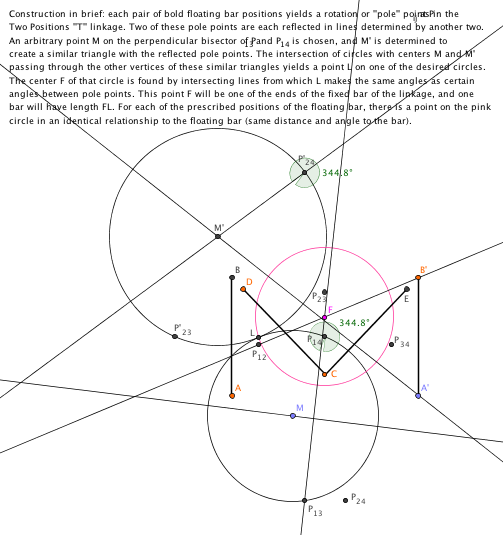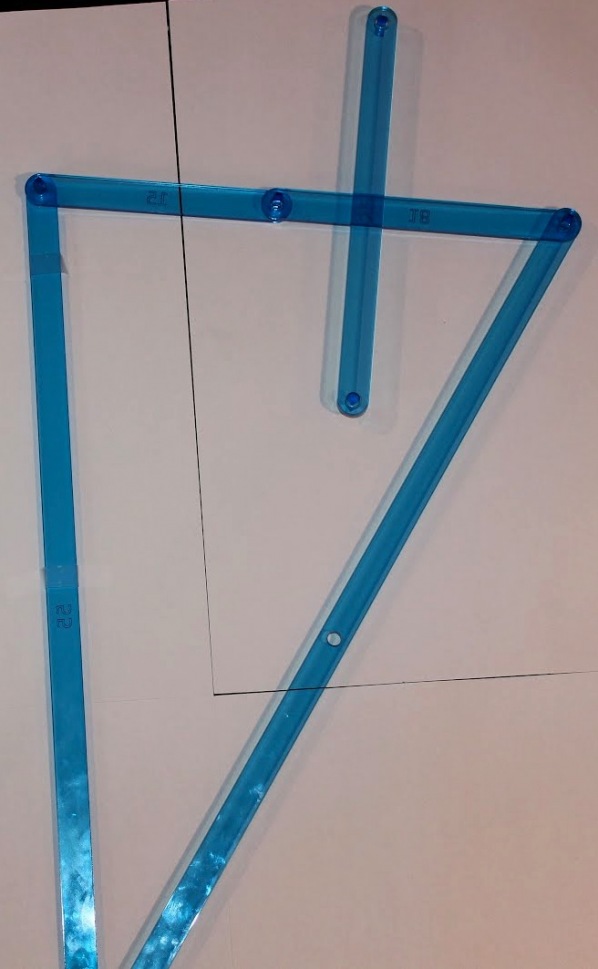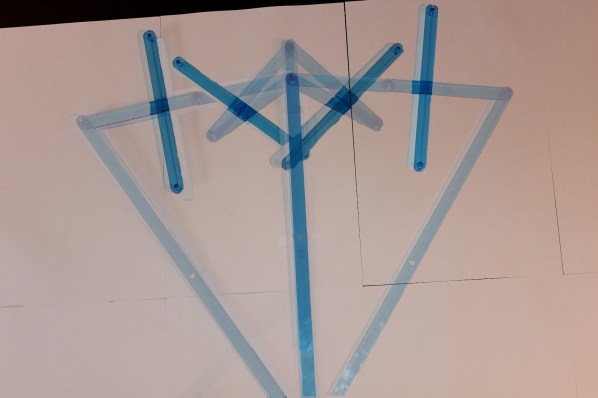Math Monday: Linkages, Part 4: Four Bars, Four Positions
by Glen Whitney
[sharethis]
Last time, we saw that a four-bar linkage can cause the floating bar to take on any two or three desired positions. What about four positions? As you may recall, each endpoint of the floating bar always lies on a circle defined by the fixed bar and one of the bars linked to it. And we know that there are four points through which it is impossible to draw a circle, such as the three corners of an equilateral triangle and its center. So we must be stuck, right? Not quite, thanks to Burmester Theory. What Burmester realized is that although the endpoints of the floating bar might not lie on a circle, there might be (and in fact are) points in fixed relationship to the floating bar which do lie on a single circle for all positions of the floating bar. Moreover, this theory gives a geometric construction to find the centers of the respective circles, which is all you need to find the linkage. I’ve applied that (somewhat involved) construction to four positions for a bar which lay out the strokes of a letter “M”, as seen in this image and Geogebra worksheet.
 This produces our next recipe:
This produces our next recipe:
4-Bar M Linkages
Ingredients: A 55-bar (A), 60-bar (B), 18-bar (C), and 15-bar (D); a 25-bar; and four linkers.
Directions: Link A to B to C to D, and then affix the 25-bar at right angles to C, about two-thirds of the way from B to D. This 25-bar will take on the positions of the four strokes of a capital M. Its endpoints do not remain on any circles; but those of bar C do, and the 25-bar is in a fixed relationship to bar C. In any case, your linkage should look like this: To use: Fix A vertically (as shown above), and rotate B to move the 25-bar successively into the four positions of the strokes of an “M”. Note that there is a slight trick, in that the link above is at what’s called a “dead point” — the joint between C and D can bend either up or down for B to rotate. You have to ease it one direction to get some of the strokes of the M, and then go back and ease it the other way to get the remainder. Here are all of the positions superimposed, once again thanks to the GIMP:
To use: Fix A vertically (as shown above), and rotate B to move the 25-bar successively into the four positions of the strokes of an “M”. Note that there is a slight trick, in that the link above is at what’s called a “dead point” — the joint between C and D can bend either up or down for B to rotate. You have to ease it one direction to get some of the strokes of the M, and then go back and ease it the other way to get the remainder. Here are all of the positions superimposed, once again thanks to the GIMP: (Note the gaps between the diagonals and uprights are as designed, see the construction sketch above.) By now we’ve created the letters “M,” “A,” and “T” for you with linkages, so I will leave you with a reader challenge: create a linkage which lays out a letter “H”! Send pictures of your creation to mondays@momath.org.
(Note the gaps between the diagonals and uprights are as designed, see the construction sketch above.) By now we’ve created the letters “M,” “A,” and “T” for you with linkages, so I will leave you with a reader challenge: create a linkage which lays out a letter “H”! Send pictures of your creation to mondays@momath.org.
This article first appeared on Make: Online, August 27, 2012.












